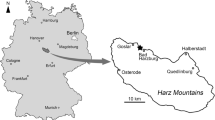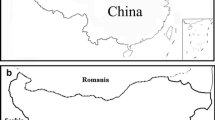Abstract
A new mammal, Mondegodon eutrigonus gen. et sp. nov., is described from the earliest Eocene locality of Silveirinha, Portugal. This species shows dental adaptations indicative of a carnivorous diet. M. eutrigonus is referred to the order Acreodi and considered, along with the early Paleocene North American species Oxyclaenus cuspidatus, as a morphological intermediate between two groups of ungulate-like mammals, namely, the triisodontids and mesonychians. Considering that triisodontids are early to early-late Paleocene North American taxa, Mondegodon probably belongs to a group that migrated from North America towards Europe during the first part of the Paleocene. Mondegodon could represent thus a relict genus, belonging to the ante-Eocene European mammalian fauna. The occurrence of such a taxon in Southern Europe may reflect a period of isolation of this continental area during the Paleocene/Eocene transition. In this context, the non-occurrence of closely allied forms of Mondegodon in the Eocene North European mammalian faunas is significant. This strengthens the hypothesis that the mammalian fauna from Southern Europe is characterized by a certain degree of endemism during the earliest Eocene. Mondegodon also presents some striking similarities with an unnamed genus from the early Eocene of India which could represent the first Asian known transitional form between the triisodontids and mesonychians.



Similar content being viewed by others
References
Antunes MT, Russell DE (1981) Le gisement de Silveirinha (Bas Mondego, Portugal): la plus ancienne faune de vertébrés éocènes connue en Europe. C R Acad Sci Paris 293:1099–1102
Antunes MT, Casanovas ML, Cuesta MC, Checa L, Santafé JV, Agusti J (1997) Eocene mammals from Iberian Peninsula. In: Aguilar J-P, Legendre S, Michaux J (eds) Actes du congrès BiochroM’97: Mém. Trav. EPHE, Inst. Montpellier. pp 337–352
Archibald JD (1998) Archaic ungulates (“Condylarthra”). In: Janis CM, Scott KM, Jacobs LL (eds) Evolution of tertiary mammals of North America. Cambridge University Press: Cambridge, Vol. 1, Terrestrial carnivores, ungulates, and ungulatelike mammals. pp 292–329
Bajpai S, Kapur VV, Thewissen JGM (2009) Creodont and condylarth from the Cambay Shale (early Eocene, 55–54 ma), Vastan Lignite Mine, Gujarat, western India. J Palaeontol Soc India 54:103–109
Chow M, Chang Y et al (1977) Mammalian fauna from the Paleocene of Nanxiong Basin, Guangdong. Palaeontol Sin 20:1–100
Clemens WA, Williamson TE (2005) A new species of Eoconodon (Triisodontidae, Mammalia) from the San Juan Basin, New Mexico. J Vertebr Paleontol 25:208–213
Clemens WA, Wilson GP (2009) Early Torrejonian mammalian local faunas from northeastern Montana, U.S.A. In: Albright LBI (ed) Papers on geology, vertebrate paleontology, and biostratigraphy in honor of Michael O. Woodburne. Museum of Northern Arizona, Bulletin 65, Flagstaff, pp 111–158
Clyde WC, Ting S et al (2010) New paleomagnetic and stable-isotope results from the Nanxiong Basin, China: implications for the K/T boundary and the timing of Paleocene mammalian turnover. J Geol 118:131–143
Cope ED (1881) The temporary dentition of a new creodont. Am Nat 15:667–669
Cope ED (1882) Synopsis of the vertebrata of the Puerco Eocene epoch. Proc Am Philos Soc 20:461–471
Cope ED (1888) Synopsis of the vertebrate fauna from the Puerco series. Trans Am Philos Soc 16:298–361
Dewar EW (2003) Functional diversity within the Littleton fauna (early Paleocene), Colorado: evidence from body mass, tooth structure, and tooth wear. Paleobios 23:1–19
Estravis C (1992) Estudo dos mamíferos do Eocénico inferior de Silveirinha (Baixo Mondego). PhD Thesis, Universidade Nova de Lisboa, pp 248
Estravis C (2000) Nuevos mamiferos del Eoceno inferior de Silveirinha (Baixo Mondego, Portugal). Coloq Paleontol 51:281–311
Estravis C, Russell DE (1992) The presence of Taeniodonta (Mammalia) in the early Eocene of Europe. Ciênc Terra (UNL) 11:191–201
Geisler JH, McKenna MC (2007) A new species of mesonychian mammal from the lower Eocene of Mongolia and its phylogenetic relationships. Acta Palaeontol Pol 52:189–212
Gill T (1872) On the characteristics of the primary groups of the class of mammals. Proceedings of the American Association for the Advancement of Science Twentieth Meeting, held at Indianapolis, Indiana, August, 1871: 284–306
Gingerich PD (1978) New Condylarthra (Mammalia) from the Paleocene and early Eocene of North America. Contrib Mus Geol Univ Mich 25:1–9
Gingerich PD (1998) Paleobiological perspectives on Mesonychia, Archaeoceti, and the origin of whales. In: Thewissen JGM (ed) Emergence of whales: evolutionary patterns in the origin of Cetacea. Plenum Publishing Corporation, New York, pp 423–449
Godinot M (1980) La variabilité morphologique dentaire du Landenodon (Condylarthra) de Dormaal (Eocène, Belgique). Paleovertebrata Mém. Jubil. R. Lavocat: 167–196
Kondrashov PE, Lucas SG (2006) Early Paleocene (Puercan and Torrejonian) archaic Ungulates (Condylarthra, Procreodi and Acreodi) of the San Juan Basin, New Mexico. In: Lucas SG, Spielmann JA, Hester PM, Kenworthy JP, Santucci VL (eds) Fossils from Federal Lands. New Mexico Mus. Nat. Hist. Bull 34, pp 84–97
Linnaeus C (1758) Systema naturae per regna tria naturae, secundum classes, ordines, genera, species cum characteribus, differentiis, synonymis, locis. Vol. 1: Regnum animale. Editio decima, reformata. Laurentii Salvii, Stockholm, Sweden
Lofgren DL, Lillegraven JA, Clemens WA, Gingerich PD, Williamson TE (2004) Paleocene biochronology of North America: the Puercan through Clarkforkian land mammal ages. In: Woodburne MO (ed) The first North American land mammal ages of the Cenozoic Era. Columbia University Press, New York, pp 43–105
Lopez-Martinez N, Pelaez-Campomanes P (1999) New mammals from south-central Pyrenees (Tremp Formation, Spain) and their bearing on late Paleocene marine-continental correlations. Bull Soc Geol Fr 170:681–696
Lopez-Martinez N, Smith R, Pelaez-Campomanes P, Smith T (2006) The acme of the micromammal Paschatherium across the Paleocene–Eocene boundary in continental Europe. Micropaleon 52:267–280
Marandat B (1997) La disparité des faunes mammaliennes du niveau MP7 (Eocène inférieur) des domaines péri-mésogéens et nordiques. Investigation d’un provincialisme intra-européen. Newsl Stratigr 35:63–82
Matthew WD (1901) Additional observations on the Creodonta. Bull Am Mus Nat Hist 14:1–38
Matthew WD (1909) Faunal lists of the tertiary Mammalia of the West. US Geol Surv Bull 361:91–120
Matthew WD (1937) Paleocene faunas of the San Juan Basin, New Mexico. Trans Am Philos Soc 30:1–510
McKenna MC, Bell SK (1997) Classification of Mammals above the species level. Columbia University Press, New York
Middleton MD, Dewar EW (2004) New mammals from the early Paleocene Littleton fauna (Denver Formation, Colorado). In: Lucas SG, Zeigler KE, Kondrashov PE (eds) Paleogene mammals, New Mexico Mus. Nat. Hist. Bull. 26, pp 59–80
O’Leary MA (1998) Phylogenetic and morphometric reassessment of the dental evidence for a mesonychian and cetacean clade. In: Thewissen JGM (ed) The emergence of whales. Plenum Press, New York, pp 133–161
O’Leary MA, Rose KD (1995a) New mesonychian dentitions from the Paleocene and Eocene of the Bighorn Basin, Wyoming. Ann Carnegie Mus 64:147–172
O’Leary MA, Rose KD (1995b) Postcranial skeleton of the early Eocene mesonychid Pachyaena (Mammalia: Mesonychia). J Vert Paleon 15:401–430
O’Leary MA, Lucas P, Williamson TE (2000) A new specimen of Ankalagon (Mammalia, Mesonychia) and evidence of sexual dimorphism in mesonychians. J Vertebr Paleontol 20:387–393
Osborn HF (1924) Andrewsarchus, giant mesonychid of Mongolia. Am Mus Novit 146:1–5
Parker TJ, Haswell WA (1897) A Text-book of Zoology, vol. 2. Macmillan and Company, London
Prothero DR, Manning EM, Fischer MS (1988) The phylogeny of the ungulates. In: Benton MJ (ed) The phylogeny and classification of the tetrapods. Clarendon, Oxford, pp 201–234
Rana RS, Kumar K, Escarguel G, Sahni A, Rose KD, Smith T, Singh H, Singh L (2008) An ailuravine rodent from the lower Eocene Cambay Formation at Vastan, western India, and its palaeobiogeographic implications. Acta Palaeontol Pol 53:1–14
Rose KD, O’Leary MA (1995) The manus of Pachyaena gigantea (Mammalia: Mesonychia). J Vertebr Paleontol 15:855–859
Rose KD, Rana RS, Sahni A, Kumar K, Singh L, Smith T (2009) First tillodont from India: additional evidence for an early Eocene faunal connection between Europe and India? Acta Palaeontol Pol 54:351–355
Russell DE, Zhai RJ (1987) The Paleogene of Asia: mammals and stratigraphy. Mém Mus Natl Hist Nat, Sér C, Sci Terre 53:1–488
Schoch RM (1986) Systematics, functional morphology and macroevolution of the extinct mammalian order Taeniodonta. Bull Peabody Mus Natl Hist, Yale Univ 42:1–307
Scott WD (1892) A revision of North American Creodonta with notes on some genera which have been referred to that group. Proc Acad Nat Sci, Philadelphia 4:291–323
Smith T, Rana RS, Missiaen P, Rose KD, Sahni A, Singh H, Singh L (2007) High bat (Chiroptera) diversity in the Early Eocene of India. Naturwiss 94:1003–1009
Spaulding M, O’Leary MA, Gatesy J (2009) Relationships of Cetacea (Artiodactyla) among mammals: increased taxon sampling alters interpretations of key fossils and character evolution. PLoS ONE 4:e7062
St Clair E, Boyer DM, Bloch JI, Krause DW (2010) First records of a triisodontine mammal, Goniacodon levisanus, in the late Paleocene of the Northern Great Plains, North America. J Vertebr Paleontol 30(2):604–608
Szalay FS (1969a) The Hapalodectinae and a phylogeny of the Mesonychidae (Mammalia, Condylarthra). Am Mus Novit 2361:1–26
Szalay FS (1969b) Origin and evolution of function of the mesonychid condylarth feeding mechanism. Evolution 23:703–720
Szalay FS, Gould SJ (1966) Asiatic Mesonychidae (Mammalia, Condylarthra). Bull Am Mus Nat Hist 132:129–173
Tabuce R, Antunes MT, Sigé B (2009) A new primitive bat from the earliest Eocene of Europe. J Vertebr Paleontol 29:627–630
Thewissen JGM, Cooper LN, Clementz MT, Bajpai S, Tiwari BN (2007) Whales originated from aquatic artiodactyls in the Eocene epoch of India. Nature 450:1190–1194
Ting S, Li C (1987) The skull of Hapalodectes (Acreodi, Mammalia), with notes on some Chinese Paleocene mesonychids. Vertebrata PalAsiatica 25:161–186
Van Valen L (1966) Deltatheridia, a new order of mammals. Bull Am Mus Nat Hist 132:1–126
Van Valen L (1969) The multiple origins of the placental carnivores. Evolution 23:118–130
Van Valen L (1978) The beginning of the age of mammals. Evol Theory 4:45–80
Williamson TE (1996) The beginning of the age of mammals in the San Juan Basin, New Mexico: biostratigraphy and evolution of Paleocene mammals of the Nacimiento Formation. N M Mus Nat Hist Bull 8:1–141
Williamson TE, Carr TD (2007) Revision of the problematic early Paleocene genus Oxyclaenus (Mammalia:Oxyclaenidae) and a new species of Carcinodon. J Vertebr Paleontol 27:973–986
Wortman JL (1899) Restoration of Oxyaena lupina Cope, with descriptions of certain new species of Eocene creodonts. Bull Am Mus Nat Hist 139–148:139–148
Zhou X (1995) Evolution of Paleocene-Eocene Mesonychidae (Mammalia, Mesonychia). Ph.D. dissertation, University of Michigan
Zhou X, Zhai R, Gingerich PD, Chen L (1995) Skull of a new mesonychid (Mammalia, Mesonychia) from the late Paleocene of China. J Vertebr Paleontol 15:387–400
Author information
Authors and Affiliations
Corresponding author
Electronic supplementary material
Below is the link to the electronic supplementary material.
ESM 1
(DOC 51 kb)
Rights and permissions
About this article
Cite this article
Tabuce, R., Clavel, J. & Antunes, M.T. A structural intermediate between triisodontids and mesonychians (Mammalia, Acreodi) from the earliest Eocene of Portugal. Naturwissenschaften 98, 145–155 (2011). https://doi.org/10.1007/s00114-010-0747-y
Received:
Revised:
Accepted:
Published:
Issue Date:
DOI: https://doi.org/10.1007/s00114-010-0747-y




